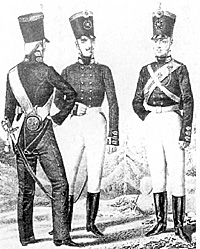
Plate 1: The Artillery of the Guard. Left to right: Gunner, horse artillery, Bombardier and
Gunner, foot artillery. All figures wear the distinctive, red and yellow guards' lace to
collars, cuffs and to the shako top band; the Bombardier equivalent to a corporal in the infantry) is distinguished by the pompom, quartered in white and black and orange, the gold lace to the top and front of the cuff and by his brown cane. The horse artillery wore dragoon -
style uniform in dark green with black facings piped red; the foot artillery wore line infantry uniforms in the same colours as their colleagues in the horse artillery. Source: Wiskowatow.
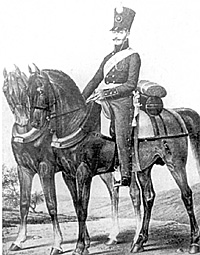 Plate 2: Driver, Foot artillery. Source: Wiskowatow
Plate 2: Driver, Foot artillery. Source: Wiskowatow
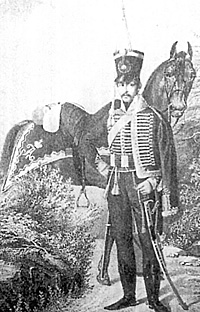 Plate 3: A private, line hussar regiment. Russian hussar uniforms were modelled on those of the 5th Prussian hussars. Each regiment was distinguished by the colours of the various item of
clothing, accoutrements and horse furniture as shown in the scheme below. In 1803 the hussars abandoned the Mirliton (winged cap) and became the first in the Russian army to adopt the shako, which the infantry took over in 1805. Each regiment had two battalions; they were distinguished by the shako pompon and cords which were white for the 1st and red for the 2nd Battalion. Troopers plumes were white, trumpeters red, those of NCOs were white with a black and orange tip, officers wore white with a black and orange base. The hussars wore their hair in three pigtails; one at the back and one over each ear, but the hair was not powdered; moustaches were worn. The fatigue cap was in the pelisse colour with a headband in the colour of the dolman or the facings.
Plate 3: A private, line hussar regiment. Russian hussar uniforms were modelled on those of the 5th Prussian hussars. Each regiment was distinguished by the colours of the various item of
clothing, accoutrements and horse furniture as shown in the scheme below. In 1803 the hussars abandoned the Mirliton (winged cap) and became the first in the Russian army to adopt the shako, which the infantry took over in 1805. Each regiment had two battalions; they were distinguished by the shako pompon and cords which were white for the 1st and red for the 2nd Battalion. Troopers plumes were white, trumpeters red, those of NCOs were white with a black and orange tip, officers wore white with a black and orange base. The hussars wore their hair in three pigtails; one at the back and one over each ear, but the hair was not powdered; moustaches were worn. The fatigue cap was in the pelisse colour with a headband in the colour of the dolman or the facings.
The fist strap, belt and slings of the sabre and the sabretasche were red, the carbine bandolier was of white leather. The sabre had a steel hilt; the scabbard was of black leather with steel fittings. The sabretasche was in the dolman colour, decorated with the imperial cypher and edging in the lace colour. The barrel sash was in the pelisse colour with knots in the lace colour. Corporals had a broad lace edging to the tops of their cuffs, sergeants and sergeant majors also had such a lace to their collars. NCOs shako cords were mixed white, orange and black. Pelisse edgings were white sheepskin for privates, black for NCOs and grey Astrakhan for officers. Neither NCOs nor trumpeters carried carbines; trumpet cords were in the lace colour for privates, mixed white, orange and black for NCOs. The Trumpet Major wore NCOs distinctions with a red base to his plume. Trumpeters wore swallo nests in the lace colour at each shoulder, but no chevrons on the sleeves. Grey breeches were introduced in 1802.
In 1803 officers were ordered to replace the gold and silver lace on their clothing with white or orange silk, but instruction went largely unheeded; their bandoliers pouches were of red Morocco leather, decorated in their lace colour. The pouch bore the double eagle .
In 1805 the regimental distinctions were as follows:
- Soum: A (pelisse) - turquoise, B (buttons and lace) - white, C (collar and cuffs of the dolman) turquoise, D (dolman) straw, E
(shabraque) - white edged turquoise, F (sabretashe) turquoise.
Pavlograd: A and C - turquoise, B - yellow, D - dark gree turquoise with yellow vandykes edged dark green, F green,
Elisabethgrad: A and D - straw, B - yellow, C, E and F - red
Mariupol: A - dark blue, B and C - yellow, D - white, E - blue F - white.
Alexandrov: A and D - black, B - white C - red, E and black.
Olviupol: A, C and D - dark green, B - white, E and F green.
Isum: A, C, E, and F - dark blue, B - yellow, D - red.
Achtyrsk: A, D, E, and F - chestnut brown, B and C - yellow.
Bielo - Rossisk: A, D, E, and F - dark blue, B - white buttons white and red cords, C - red.
Grodno (raised in 1806): A and D - dark blue, B - white buttons, red and white cords, C - light blue, E dark blue, blue vandyking, white braid, F - dark blue, light blue, white cypher and crown.
Lubny (raised 1807): A and D - dark blue, B - white buttons, red and white lace, C - yellow, E - dark blue, yellow vandyking white braid, F - dark blue.
During 1807 pigtails were abolished, the red and white lacing of the new regiments was replaced by white, the regiment Grodno and Lubny received dark blue breeches with lacing and shako cords were to be in the colour of the dolman and pelisse for the whole regiment; the pompon remained the battalion colour. It is very unlikely that these changes were implemented until after the campaign was over.
Sources: Wiskowatow, Gayda and Krijitski, Knoetel, Begunova.
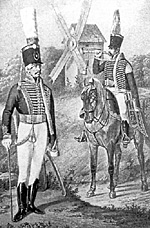 Plate 4: Officer and trumpeter, line hussars. Source: Wiskowatow.
Plate 4: Officer and trumpeter, line hussars. Source: Wiskowatow.
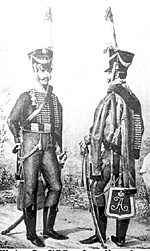 Plate 5: NCO of a line hussar regiment. Note the NCO distinctions: plume tip and pompon, no carbine or bandolier, lace in the button colour to collar and cuffs and the stick. Source: Wiskowatow.
Plate 5: NCO of a line hussar regiment. Note the NCO distinctions: plume tip and pompon, no carbine or bandolier, lace in the button colour to collar and cuffs and the stick. Source: Wiskowatow.
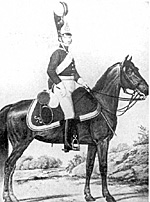 Plate 6: NCO, Line Dragoon Regiment.
Plate 6: NCO, Line Dragoon Regiment.
The dragoons wore light green coats of infantry cut but with two cloth loops added at the rear of the waist to support the sword belt. This costume was copied from the Prussian Feldjaegers. Turnbacks were red with regimental facings shown on collar, cuffs and shabraques, the imperial cypher and the edging of the shabraque were in the button colour. The brass helmet plate bore the double eagle; the cuirassier type helmet had replaced the bicorn in 1803. Distinctions for NCOs, trumpeters and officers were as for the cuirassiers, infantry and artillery, except that musicians in the cuirassiers and dragoons wore a white lace trim, having a pattern of diamonds and edgings in the facing colour, to swallows nests, sleeves, and to the rear seams of their tunics. For parades white breeches were worn, everyday and field wear was grey overalls with black leather buttons. The light green fatigue cap had a headband in the facing colour and a tassel in the squadron colour: 1st - white, 2nd - light blue, 3rd - yellow, 4th - black, 5th - green. White gauntlets were worn. The brasshilted sword was worn in a brown sheath; it had a red leather fist strap with a tassel in the squadron colour. The other armament was a short musket, bayonet and two pistols. Belts were white, the pouch had a round brass plate bearing the double eagle. Harness was black with steel fittings, the saddle was of Hungarian style; the round portmanteau was grey. The trumpets were brass although silver trumpets could be awarded for distinguished service, There was one kettledrummer per regiment, as for the cuirassiers. In 1806 queues were abolished for the men; the officers could retain them if they wished. In 1807 the officers received epaulettes as for the cuirassiers.
Sources: Wiskowatow, Alla Begunova, Knoetel, Gayda and Krijitski.
 Plate 7: Field Officer, Horse Life Guards.
Plate 7: Field Officer, Horse Life Guards.
The uniform shown is generally as for all cuirassier regiments. Peculiarities of this regiment are the eight-pointed star of the Order of St Andrew (silver rays, black, white and orange centre) worn on helmet plate, pouch, shabraque and holster covers, the guards lace loops to collar and cuffs, silver buttons and lace and the red facings and saddle furniture. Line cuirassiers wore the double eagle on their helmets, and pouches (except for the regiment Military Order - also sometimes called St George - which wore the fourpointed star of the Order of St George), had no laces on collar or cuffs and wore the imperial cypher on their saddle furniture. The huge, bottle brush crests were black for troopers, red for trumpeters, black with a white front having an orange vertical stripe edged black down the centre for NCOs and black with a white front separated from the black rear by an orange ring for officers. Generals plumes were all white.
Sources: Wvskowatow, Alla Beuunova, Knoetel.
More Russian Army 1807
- Russian Army 1807: Introduction and OOB
Russian Army 1807: Black and White Plates #1-7
Russian Army 1807: Black and White Plates #8-14
Russian Army 1807: Color Plates
Back to Table of Contents -- Age of Napoleon #31
Back to Age of Napoleon List of Issues
Back to MagWeb Master Magazine List
© Copyright 1999 by Partizan Press.
This article appears in MagWeb (Magazine Web) on the Internet World Wide Web. Other military history articles and gaming articles are available at http://www.magweb.com